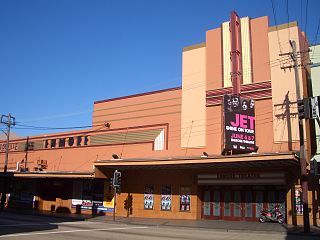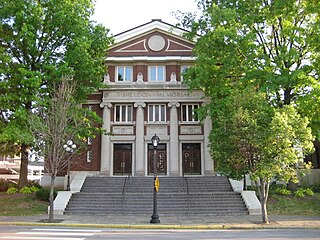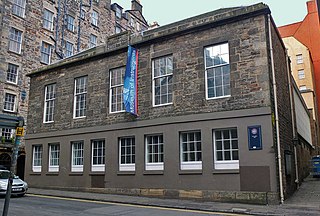
The Enmore Theatre is a theatre and entertainment venue in Sydney, Australia. It was built in 1908. It is located at 118–132 Enmore Road in Newtown, in the inner west of Sydney's suburbs. It was first opened in 1912 as a photo-play theatre. It was run by a well-known theatre family at the time, the Szarka Brothers. Today's Enmore Theatre is the longest running live theatre in Sydney, hosting concerts, comedians, plays and all forms of performance. The theatre is considered a medium-sized venue that holds 1,700 people when fully seated and 2,500 when seats are removed, and all attendees are standing. It has hosted many international bands including a performance by Bob Dylan. The venue's art deco style is protected by its listing as a historic building within Sydney. The Enmore theatre has had many renovations and shifts of ownership. Today it is owned by Century and has hosted a range of arts from photographic, performing arts, music and motion picture. The theatre's listing in the Office of Environment and Heritage states that the building "illustrates the development of suburban theatres in the late 1930s and early 1940s and is of social significance for the local community.″ It is the only theatre in Sydney from the Art Deco movement in its original condition. From cinema use to concerts, today is used for various reasons.

The De La Salle Santiago Zobel School, also referred to by its acronym DLSZ or De La Salle Zobel, is a private Catholic basic education institution for boys and girls run by the Philippine District of the De La Salle Brothers in Muntinlupa City, Metro Manila, Philippines. It was opened in 1978 by the De La Salle Brothers because of the increasing number of students in the grade school department of the former De La Salle College in Manila.

The Rizal Memorial Sports Complex (RMSC) is a national sports complex of the Philippines, located on Pablo Ocampo St., Malate, Manila. It is named in honor of the country's national hero, José Rizal. The complex is currently managed by the Philippine Sports Commission, while the property is owned by the Manila City government. The complex also houses the administrative office of the PSC, and quarters for the Philippine national athletes.
The National Music Competitions for Young Artists Foundation or NAMCYA was founded in the Philippines in 1973. It was created by virtue of President Ferdinand Marcos' Presidential Proclamation No. 1173, which declares the period between November 26 and December 12 every year as National Week for Young Artists.

Leandro V. Locsin was a Filipino architect, artist, and interior designer known for his use of concrete, floating volume and simplistic design in his various projects. An avid collector, he was fond of modern painting and Chinese ceramics. He was prod a National Artist of the Philippines for Architecture in 1990 by the late President Corazon C. Aquino.

St. Scholastica's College, Manila, also referred to by its acronym SSC or colloquially St. Scho) is a private Catholic Catholic basic and higher education institution for women founded and managed by the Missionary Benedictine Sisters of Tutzing in a 3.66 hectare lot in Malate in the city of Manila. It is bounded by Estrada Street on the north, P. Ocampo Street on the south, Singalong Street on the east and Leon Guinto Street on the west. It was established in 1906 initially offering elementary grades. It started admitting high school students in 1907 and opened its collegiate department in 1920. It pioneered in formal music education in the Philippines, opening a Conservatory of Music in 1907. Although St. Scholastica's College is an exclusive school for women, admission of male students in the Music, Fine Arts, and Interior Design programs has been allowed.
Adolovni Acosta is a Philippine-born classical pianist. Acosta is the daughter of Guillermo and Ernestina Acosta. She is a notable concert pianist and recitalist.

The Sheldon Concert Hall in St. Louis, Missouri was designed by noted 1904 World's Fair architect Louis C. Spiering and built in 1912 as the home of the Ethical Society of St. Louis. Musicians and public speakers throughout the years have enjoyed the perfect acoustics of the Sheldon Concert Hall, earning The Sheldon its reputation as "The Carnegie Hall of St. Louis." Well-known singers and ensembles have performed at The Sheldon, and speakers such as Albert Einstein, Dwight Eisenhower and Ernest Hemingway have spoken from its stage. The St. Louis Chapter of the League of Women Voters was founded in The Sheldon's Green Room.

The Rizal Memorial Coliseum is an indoor arena located inside the Rizal Memorial Sports Complex in Manila, Philippines. The capacity of the coliseum is 6,100.

The Manila Metropolitan Theater is a Philippine Art Deco building found near the Mehan Garden located on Padre Burgos Avenue corner Arroceros Street, near the Manila Central Post Office. It was designed by architect Juan M. Arellano and inaugurated on December 10, 1931.
The Manila Symphony Orchestra (MSO) is one of the oldest orchestras in Asia. Founded by Alexander Lippay in 1926, the orchestra has played a major role in Philippine history, including acting as a symbol of resistance during the Second World War. Through the years, MSO has hosted artists Montserrat Caballé, Yehudi Menuhin, Igor Oistrakh, Eugene Istomin, Fou Ts'ong, Barry Tuckwell, Paul Badura-Skoda and Rony Rogoff, as well as conductors Andre Kostelanetz, Arthur Fiedler, Mendi Rodan, Robert Feist, Gareth Nair, Helen Quach, and Eduard Strauss II. Today, the Manila Symphony Orchestra provides a showcase for young Filipino musical talent.

Lucrecia Roces Kasilag was a Filipino composer and pianist. She is particularly known for incorporating indigenous Filipino instruments into orchestral productions.

St Cecilia's Hall is a small concert hall and museum in the city of Edinburgh, Scotland, in the United Kingdom. It is on the corner of Niddry Street and the Cowgate, about 168 metres (551 ft) south of the Royal Mile. The hall dates from 1763 and was the first purpose-built concert hall in Scotland. It is a Category A listed building.

Pablo Ocampo Street, also known simply as Ocampo Street and formerly and still referred to as Vito Cruz Street, is an inner city main road in Manila, Philippines. It runs west-east for about 3.448 kilometers (2.142 mi) connecting the southern districts of Malate and San Andres southeast to Makati.

The Church of Sainte-Thérèse-de-l'Enfant-Jésus, is a former Roman Catholic church located in the city of Hirson, Aisne, France. A concert hall, it is in the Art Deco architectural tradition.
Andrés Pardo de Tavera Luna is a Filipino architect who built the first air-conditioned building in the Philippines, the Crystal Arcade one of the popular tenant of Manila Stock Exchange Building that was once located on No. 71 Escolta Street, Binondo, Manila. He was assigned as the city architect of the City of Manila from 1920 to 1924. His designs were modernist. Some of them were lost during World War II.

The Tanghalang Pambansa, formerly Theater of Performing Arts, is a theater located in the Cultural Center of the Philippines Complex in Manila, Philippines.
Pedro Siochi was a notable Philippine architect and civil engineer of famous landmarks in the Philippines.














